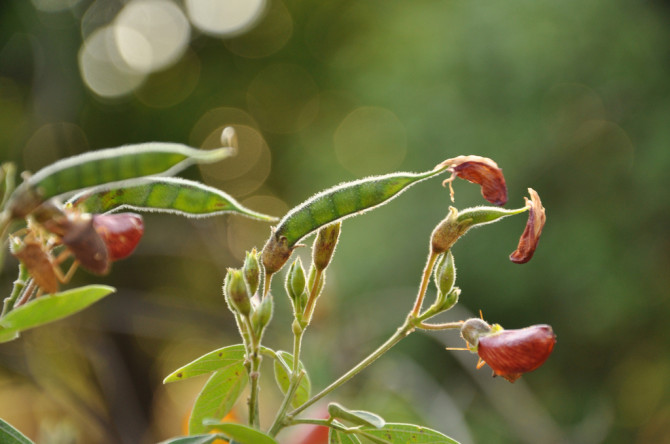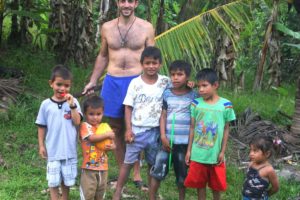
David Fleck collecting coconuts with his sons and nephews ©Acaté
It’s not easy reaching Matsés territory, but finally, after a week of saying goodbye to my family in Iquitos only to return a couple hours later with yet another cancelled flight, the Peruvian Air Force float plane took off and soared off into the horizon. I was headed for the small Peruvian military outpost of Angamos, the gateway to the territory of the Matsés indigenous people. After a couple of carefully navigated turns in the approach, the float plane touched down on the Rio Javari, the river that straddles the divide of the nations of Peru and Brazil within an otherwise boundless expanse of rainforest.
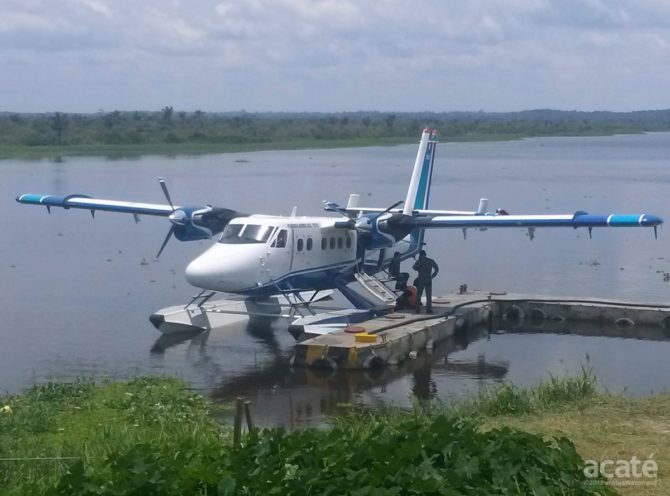
Flights for Angamos are unpredictable and depend on availability of planes and the weather.
A small outpost at the edge of the frontier, Angamos is at the convergence of two worlds. The police and military presence in Angamos is ever felt, as well as that of businessmen looking to strike it rich selling the valuable timbers that lay untouched in the forests upriver. The Matsés certainly value being able to buy clothing, batteries, shotgun-shells, and, most importantly, gas from the numerous small stores run by Peruvian settlers, who are usually willing to trade for chickens, farinha, or bush meat. Yet after witnessing so many in the United States and Peru struggling with junk food and television, it’s discouraging to see the Matsés also now being introduced to these things during their visits to Angamos.
Acaté’s field coordinator, Dr. David Fleck, lives in the Matsés village of Estirón on the Chobayacu river, approximately one day upriver by peque peque (dugout canoe with long shaft small horsepower motor) in the rainy season. In the dry season, when water levels drop so low as to expose submerged trees at the bottom, the river can be almost impassable. I hear a lot of talk about “living off the grid” in the United States and elsewhere, but Dave is the real deal. The only food item he purchases is coffee to back up the supply from his own coffee bushes. He has solar panels, rainwater catchment, and basically lives as close to a zero impact lifestyle as possible. Yet, the jungle does not simply lend itself to an idyllic utopian existence. In reality, the Amazon is one of the harshest and most unforgiving of landscapes to inhabit on the planet. The fact that the Matses and other indigenous groups thrive in this environment is testament to their resilience, skill, and ingenuity.

Dr. David Fleck and family in Estirón
Dave’s home in Estirón is where the initial phases of Acaté’s permaculture work are being done. Acaté’s goal is to assist the Matsés in adapting their farms to their new more permanent settlement patterns. Historically, the Matsés were semi-nomadic, their villages small and transient. Farms were cut out of the surrounding rainforest through swidden (slash-and-burn) approaches, which resulted in dump of nutrients into the thin rainforest topsoil. No longer held down by the roots of the large rainforest trees, the soils erode with the rains and farms become non- productive after a few years. At that point, the Matsés would simply pack up and not return to that location, allowing the jungle to reclaim the land. If they did return, it was only after the passage of many years, at which time the forest would be nearly indistinguishable from the surrounding forest.
Now, since sustained contact, they are settled in fixed villages which have infrastructure and support larger populations. The jungle is not able to reclaim eroded fields before the edge of the jungle is cut back yet further, resulting in ever-expanding rings of degraded land around their villages. The Matsés women, who traditionally do all the harvesting, commonly walk up to two hours to simply reach the farms. Each day they traverse this distance in the return, carrying very heavy baskets of manioc or bunches of bananas. Newly cut fields are cut sometimes so far away that they require transportation by outboard motor, requiring fuel, which drives a cash economy. Many young men are leaving the communities to seek income from jobs cutting timber or gold mining to the south in the Madre de Díos region of Peru. The Matsés elders have asked Acaté to work them to transition away from slash and burn practices, provide economic alternatives to timber and gold, and mitigate the social disruption caused by the absence of young men.
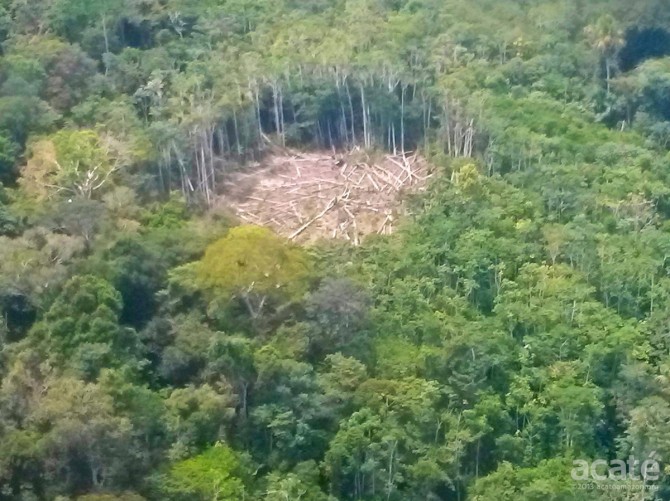
Aerial view of a recent jungle clear-cutting for a subsistence farm ©Acaté

Dave’s farm after the clearing burn ©Acaté
Outdated Slash-and-Burn Approaches Chip Away at Rainforests throughout the Tropics
Since small-scale agriculture is one of the leading drivers of deforestation in the tropics the solutions implemented with the Matsés have global importance. In order to achieve meaningful a real and sustainable manner, we have to learn from the mistakes of the past. Too often, the approach of international development projects could be described by the old saying, “when you have a hammer, everything looks like a nail.” In this case, the “hammer” is usually purchased from politically- connected business interests in the form of seeds and equipment of the so-called “green revolution”, replacing one commercial dependence with another. In order to avoid this pitfall, and develop truly sustainable and intrinsic systems, Acaté began the project by carefully learning from Matsés traditional swidden agriculture. What we discovered is a very advanced system perfectly adapted to a once semi-nomadic way of life, a system that needed modification, not complete overhaul, to adapt to the new existence. The full complexity of their agricultural system is only understood by experienced Matsés farmers but I attempt below to provide a basic overview:
Traditional Farming Practices of the Matsés
Site Selection: Matsés prefer to farm on flat ridge tops covered by primary forest as close as possible to their homes. Families often work along a ridge line over time as the farms are cut and abandoned. They have three types of soils they recognize, black, sandy and red clay. Black soil is preferred followed by sandy and rarely a farm will be cut in red clay. The presence of Tagua (Phytelephas macrocarpa), Attalea tessmannii and Ungurahui (Oenocarpus bataua) are used as indicators of land fertility. The presence of leaf cutter ants on or near the site would make it unacceptable for a new farm.
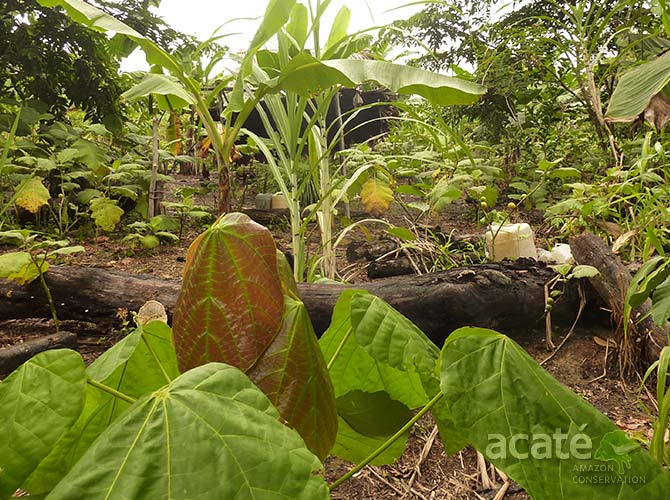
Example chacra (small farm) clearing around an indigenous Matsés community in the Peruvian Amazon © Acaté
Land Preparation: Once a suitable area of between one-half to one hectare is found a single family will begin clearing the understory with machetes. Useful fruit, thatch and medicinal species are spared from removal or fire damage, if possible.
Once the understory is ready the entire community is invited to fell the trees with axes. Work starts at the bottom of the slope and works up, partially cutting the trunks. After all trunks are partially cut, one big tree near the top is felled creating a domino effect and knocking all the trees down. Once the trees are felled the remainder of the work is done by the family that owns the farm. After a month of drying the area is burned. For areas with large trees a second burn is often performed. Farms are usually cut in the dry season to facilitate the burn with July and August being the most popular months.
Planting: As soon as the burn is complete Matsés begin planting. The exact mix of the polycultures is site and farmer specific, but generally includes some or all of the following in general order of abundance: Four varieties of manioc, three varieties of plantains, ten varieties of sweet bananas, papaya, corn, pijuayo (Bactris gasipaes), sugarcane, pineapple, peppers, tobacco, sweet potatoes, bottle gourds, cocona (Solanum sessiliflorum), dale dale (Calathea allouia), sacha papa morada (Dioscorea trifida), papa huitina (Xanthosoma sagittifolium), huaca (Clibadium remotiflorum), cotton, jergon sacha (Dracontium loretense), and arrow cane (Gynerium sagittatum).
Planting generally starts with placement of plantains in areas with the most ashes. Plantain density is also judged by the amount of ashes available due to their high nutrient requirements. Manioc is then filled in around two meters from the plantains, and planted with one and a half meter spacing. The manioc is planted by men and the plantains by women. Corn can be intercropped with the manioc or planted in its own patch if there is an area of abundant ashes. The rest of the polyculture is filled in with papaya and tobacco being placed near large unburned logs, and the rest is planted depending on soil type, hydrology, shading, and ash quantity. Rhizomes and seeds from the previous year’s best producers are selected for planting in the new farms.
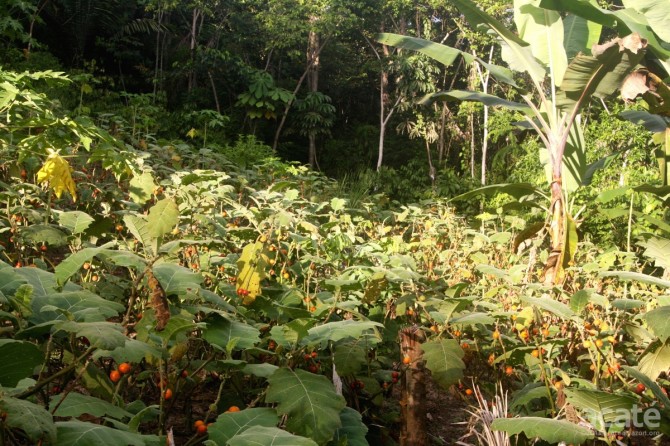
Traditional Matsés alley cropping of cocona amidst plantain and papaya. ©Acaté
Weeding, Pest Control and Fertilization: All the farms are rain fed with clever placement of the plants providing adequate moisture. Weeding is done every two or three months with volunteer fruits and medicines being left alone, especially Inga species. In cases of prolific weed growth they may be cut and piled for an additional burn but generally no inputs are added after planting. Sickly and weak plants are cut while weeding and caterpillars and other pests are removed by hand, especially from corn and tobacco. Small rodents are controlled with dead fall traps, and spiny rats are eaten if caught. Agoutis and other larger animals are hunted in the farms at night if they are observed to be causing too much damage. Dead snags are left to attract raptors to control rodents.

Matsés dead fall trap to catch rodents. ©Acaté
Harvest: The first harvest for a new farm usually occurs after one year. Matsés families may have up to three farms, with two producing at any time, making harvesting patterns irregular. A farm that is three years old may still have manioc to harvest along with fruits. Depending on soil quality a two year old farm might still be very productive but after the third year farms are abandoned. Large manioc harvests are done to make farinha and corn is harvested to make large batches of porridge. In general the Matsés women, who do all the harvesting, take produce when it is ripe or as needed for daily meals.
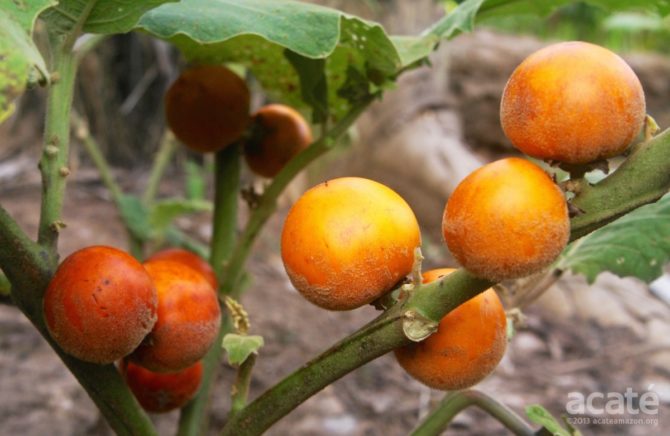
Ripe and ready cocona fruit, perfect for many traditional jungle dishes. ©Acaté
With this background information we were able to craft a plan that incorporates Matsés knowledge and needs within the framework of agroforestry and permaculture. I can’t say enough about how valuable the contributions of Dave Fleck are to this work. He is a walking encyclopedia of Matsés cultural practices and his in-laws Lucho and Marina are master farmers.
By starting our work near Dave’s home and working with Lucho and Marina we can experiment and refine the designs without losing credibility with the Matsés when there are setbacks. The Matsés do not generally like to talk a lot about what they are going to do, they prefer to do it and then describe what they did. They even have specific verb tenses in their language for different degrees of certainty in describing something that happened. So it’s critical that we build from small successes without over-promising. It was amazing to walk with Maria and look at her three productive farms. She is so hard working and generous and I was duly impressed by the diversity of her polycultures; the size of the plants and the lack of pest damage. Replicating the nutrients and yields from the burns will definitely be a major design challenge!
Introducing Permaculture Design into Traditional Matsés Agriculture
My time in Estirón allowed me to work with Dave and check on the progress of the Acaté demonstration farm. In selecting the site we took advantage of an unused area that faces southeast and has a 30% grade. As it is undesirable for the Matsés it provided a great opportunity close to the village to show how alley cropping works without causing disruption to their available farming areas and thus food supply.
The overall concept is to have a guaba (Inga edulis) and pigeon pea (Cajanus cajan) alley cropping system for rotation of manioc, corn, peanuts, cocona, cowpea and peppers. The guaba, pigeon peas, peanuts, and cowpeas are all nitrogen fixers and the presence of red nodules indicates nitrogen fixation is actually taking place. Guaba is also a nutrient accumulator making its leaves ideal mulch. Due to the grade of the area, erosion is a concern, so we have established vetiver (Chrysopogon zizanioides) swales (tightly spaced lines of vetiver planted on contour). The vetiver is easy to control; grows quickly; repels pests; holds the soil and arrests water flow better than any other available species. In addition the fibers can be used for making crafts, and the roots are used for fragrances and perfumes that may have potential export use in Angamos and nearby outposts. The vetiver was planted simultaneously with the guabas so that the vetiver can grow rapidly to stop erosion while the guabas are established. As the guabas grow they will shade the vetiver preventing further growth, but the dormant vetiver will help keep the swales intact. Once the guabas are ready for coppicing for fuel wood and nitrogen release, the vetiver will enjoy the sunlight and resume growth until the guaba’s regrowth.
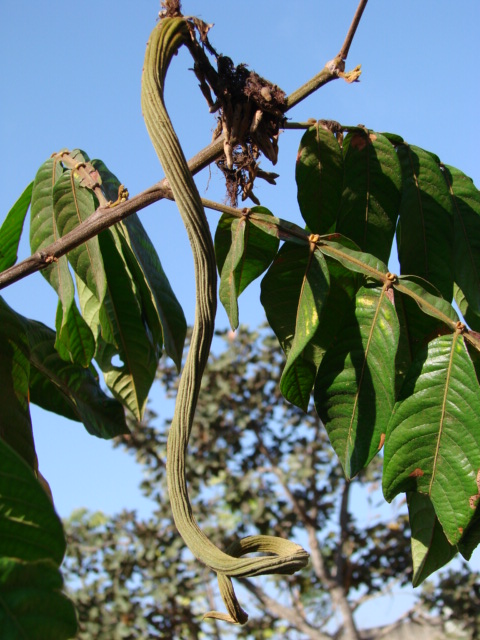
Inga spp. trees are fast growing, nitrogen fixing, useful fuel wood source, and food/fodder. photo credit: João de Deus Medeiros cc
Pigeon peas were added to the tree rows due to their rapid initial growth they will help nurse the young guabas as they establish themselves. At the onset of the wet season, they will be harvested for their peas, and coppiced to produce mulch.
A dense cop of cocona was planted in the alleys to prevent weeds from establishing themselves in the field and to protect the delicate soil. Cocona grows rapidly, casting deep shade and the broad leaves fall off naturally before harvest adding important mulch. Additionally it makes excellent juice that the Matsés enjoy.

Cocona (Solanum sessiliflorum) is a native fruiting herbaceous annual used in many traditional Matsés dishes photo credit: Colaspidae cc
Peanuts and the other crops were subsequently planted in the mulch, initially at low density. Peanuts and cowpeas are to be rotated with manioc, peppers and corn. In addition we emulated Matsés farming and added dale dale, papa huitino and allowed volunteers like huaca to establish themselves. Huaca is used for fishing after the leaves are mashed and placed in baskets. It has chemicals that temporarily remove the oxygen from the water making the fish jump for easy netting. The effects are temporary and it has no toxicity to humans. The leaves are also put inside caterpillars and the caterpillars are used as bait. The caterpillars are usually collected while weeding and removing pests from corn.
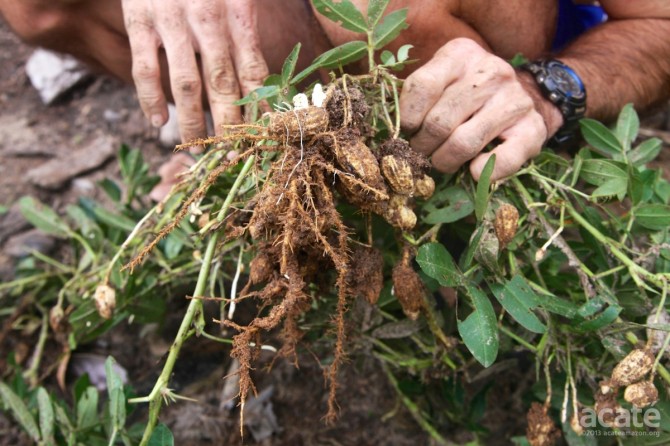
Harvesting maní (peanut), a Matsés favorite. ©Acaté
At the bottom of the slope we planted bananas and papaya in and around mulched infiltration basins to capture nutrients that might run off the slope while the vetiver grows into an effective barrier. A perimeter of lemon grass was established around the entire field as a deterrent to leaf cutter ants and to mask the crops from other pests.

Vetiver swale (tall, thin leaves) below cocona and huaca. ©Acaté
This alley cropping system uses minimal labor; has nutrient cycling; nitrogen fixation; nutrient accumulation and produces staple crops for the Matsés as well as beans and peanuts, which are currently purchased at high prices from non-Indians. The abundance of earthworms and mushrooms in the field are indicators of rich soil biota and give reason to expect durable yields. Expanding on this model could be a key for regenerating degraded land adjoining Matsés communities and assuring food security throughout lowland Amazonia.

Ice-cream bean (Inga spp.) showing nitrogen fixing nodulation on its roots. ©Acaté
Acaté is also working on improving Matsés kitchen gardens. We are making compost from the limited locally available materials. The richest locally available input is the muck from the bottom of the fish pond. The muck is being added to fresh guaba leaves, forest leaf litter and inoculated with black soil from the forest. The dried leaves are added as needed to balance the carbon content. We are also experimenting with top dressing the muck directly onto the plants. The muck is very dense, however there is no indication that it is causing water logging but further experimentation is ongoing.
Banana circles are another technique we are using to boost production adjacent to Matsés homes. Small circular mounds are built and four bananas are planted around the circumference, equidistantly spaced. Organic waste is placed in the center of the circle, especially leaves and stalks from the bananas, and allowed to decompose. Once the organic material is broken down it can be used to top dress the bananas and rebuild the circular mounds. This creates a closed loop system of fertilization for the bananas. We are also adding kitchen waste and ashes from the cooking fires to the circles for extra nutrients.

A mulched banana circle pit for improved nutrient recycling and retention ©Acaté
Near the bananas, outside of the circle, nitrogen fixers such as beans and guabas are planted and sweet potato is used as a ground cover to combat encroaching grass. Near the circle other fruit trees are planted in leaf baskets for citrus or surrounded by logs in the case of achiote (Bixa orellana) coconuts and avocado. The idea is to replace the grass gradually using shade from productive trees. Digging out grass is labor intensive and often ineffective. In this manner a non-productive grassy area is converted into a shaded, mixed orchard with minimal labor using only kitchen wastes. Typically plantains are the most difficult to grow of the banana varieties and will not produce in heavily weathered soil. Using the circles we have successfully grown large bunches of plantains and are waiting to see the results from the papayas. Seeing Marina smile with approval while looking at the plantains was extremely gratifying.
In preparation for expanding our project, we have started working on an accelerated successional profile for larger agroforestry sites in degraded areas. We have established the utility of guaba as a source of fruit, firewood, nutrient accumulation, and mulch production. We are now working on cultivating other colonizer species to accelerate the planting of climax species like Ungurahui. Ungurahui is a very important species for the Matsés so we are taking soil from existing mature trees to propagate the mychorhizal fungi needed for the trees to grow well. In the experimental field, a recently abandoned farm dominated by grasses, we are experimenting with adding colonizers like Cecropia sp., bolaina (Guazuma crinita), macambo (Theobroma bicolor), sangre de grado (Croton lechleri), and Bellucia grossularioides all of which are productive themselves. The project area is close to existing forest so desirable fruit species, such as Bactris sp., Theobrama sp.,and othersand useful trees like balsa (Ochroma pyramidale) are allowed to grow while potential invasive species such as Vismia are removed.
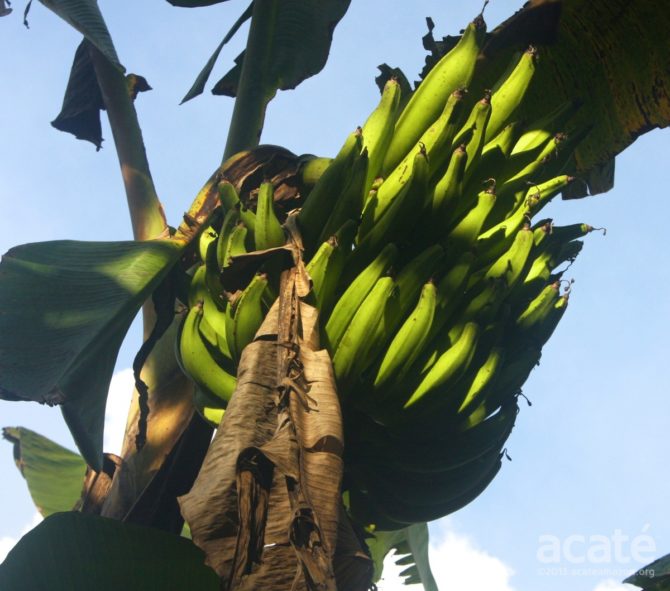
Large plantains in a Matsés farm plot. ©Acaté
Recent archaeological evidence shows that centuries ago Amazonian societies were able to support large populations than once thought possible in the rainforest. The agricultural knowledge and techniques that kept their farms productive was lost in the devastation that followed European conquest and disease. Indeed, the semi-nomadic nature of the Matsés and that of other tribes before ‘contact’ in the 20th century is, in many ways, an adaptation to that fragmentation. This lost knowledge of sustainable agriculture is what Acaté and the Matés are trying to reclaim. These systems have the potential to provide the Matsés with food security and mitigate the other challenges caused by the unsustainable agriculture. Combined with our eco-social entrepreneurship work these programs, we can help preserve 2.3 million acres of forest and provide a readily adaptable model for others groups and regions in the tropics.
Acaté Amazon Conservation has some very exciting developments in the works so stay tuned for future updates, explore more permaculture photos here, and please consider supporting our work with a donation!

